20. Ephraim Hallam's legacy: the story of two houses
A Davenport History Feature - by Charlie Hulme
Davenport Station home | Index to History pages
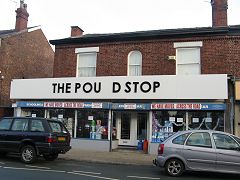
The arrival in 2014 of a new business at the former 'Davensport' shop at 201 Bramhall Lane prompted us to take a look at the history of this shop, The Pound Stop, which opened in time for Christmas 2014, and its neighbours.
In 2021 we have revised the text with new information and more about the people who have lived at nos. 201 and 203 over the years. It's been a difficult task and there are gaps and probably errors: if you can fill them, or have any photographs of the people mentioned, you are very welcome to make contact.
charlie@
davenportstation.org.uk
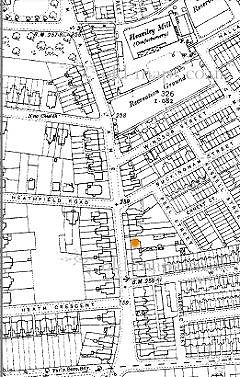
Bramhall Lane in 1910 with No. 201 marked in orange. The streets created on Ephraim Hallam's land were given names with a Royal, Ducal or Prime Ministerial theme.
Many of the smaller houses in these back streets were declared unfit, and replaced, in the mid-twentieth century; the present-day street pattern retains the names, but with a different layout.
Ephraim Hallam's story
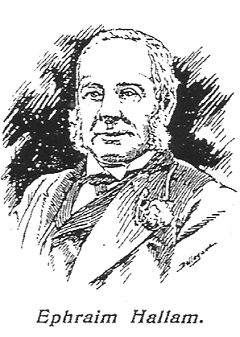
Ephraim Hallam (1812-1897) was a mill owner who made his mark on the Stockport area, and his name remains significant long after his death. At a first sight of his history, it might appear that he was the son of some wealthy mill-owner, but this was not the case.
He was born in Stockport in 1812, a son of John and Mary Hallam (spelled Hallum in some documents). The family lived in a terraced house in Canal Street where they ran a hand-powered cotton-spinning business, in the house and in premises in nearby Hope's Carr.
The tools of the trade included the 'Spinning Jenny' with which one person could spin a number of threads at the same time. John's will also mentions a 'Slubbing Billy', a hand-worked machine which had been invented by 'a gentleman in Stockport'.
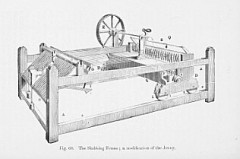
This was a variation on the Jenny to speed up 'slubbing' the preparation of 'rovings' to feed the Jenny.
The family
John and Mary Hallam had six children: Samuel the eldest, then Ephraim, Phoebe, Mary Ann, Elizabeth, and John. Tracing them in known records is difficult; others before me have pieced together some of the story, but records from time are scanty.
Phoebe married Samuel Taylor of Bramhall; Mary Ann married John Waites, a master spinner, and in 1854 Elizabeth married David Fogg, a book-keeper who rose to become the manager of Heaviley Mill. The life of John (junior), born in 1825, has proved impossible to find.
John (senior) died in 1835, by which time his oldest son Samuel appears to have had his own spinning business in Stockport, but from around 1845 he disappears from local records: there is some evidence that he emigrated to America.
John's will left bequests for this wife and all his children, except that Ephraim, who was already in business as a Chemist, was to receive only the share allocated to any of the children should they die before the age of 21 without issue.
Ephraim's early life
As a boy, it is said that Ephraim studied Latin under a Unitarian Minister, and would walk to Manchester every week to attend the Chemistry lectures of Professor Davies, assistant to famous chemist John Dalton. He set up in business as a chemist and druggist in Stockport, and in 1834 married Mary Ann Barlow of Heaton Norris; they made their home in Shaw Heath, where the 1841 census lists them and also his mother Mary Hallam, and a John Hallam, possibly his younger brother although the dates don't match.
An 1834 Stockport directory does not list him among the chemists and druggists, although his father's will does describe him as such.
The order of events around the 1830s, seen through the blurred lens of incomplete documents, is not clear, but some time before 1845 he gave up his pharmacy career and set up a mechanised cotton spinning business in Higher Hillgate. This had been built for Samuel Oldknow in the 1780s, and later became part of the Christy hat-making empire.
Cotton waste spinning was something of Stockport speciality, re-cycling waste cotton into a product which could be spun into 'candlewick', a soft, thick, heavy, loosely twisted cotton yarn used for making such things as tufted bedspreads, towels, and carpets.
The business must have prospered, as - perhaps also with the proceeds from the sale of his druggist business - he was able to commission a purpose-built modern spinning mill.
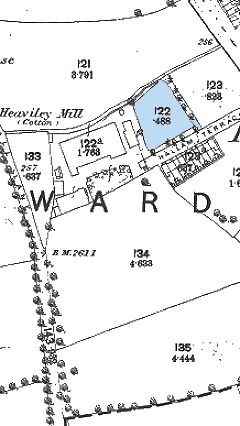
He chose a site by Bramhall Lane in Heaviley, where the mill began operation in 1859. (The map above is from the 1870s. ) Why he chose that location is unknown, although a map from the period appears to suggest that a watercourse once existed there along what became a pathway called 'Hallam's Passage'. A well 450 feet deep provided the water source for the two Martin and Smethurst compound horizontal engines to drive the machines.
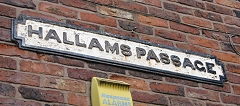
By 1851 Ephraim had moved, with his wife Mary Ann, to a house in Higher Hillgate. By 1861 they had moved again, to one of the up-market houses of Adswood Grove. His wife Mary, died (childless) in 1863, and in 1864 he married again, to Hannah Kershaw Andrew, daughter of Jerry Andrew, cotton spinning mill owner, of Mossley. This marriage also failed to produce an heir.
He served the community as a borough councillor, and served as Mayor of Stockport in 1862-3, during the 'cotton famine' caused by the American Civil War and other factors which led to many workers being laid off. He organised, with other wealthy locals, a fund which collected £300 for the relief of distressed workers. He also served as Alderman and Justice of the Peace.
From 1859 to 1879 he was representative for the Stockport circuit of the Methodist New Connexion. He donated funds for the building of Mount Tabor chapel, which stood near the Town Hall until demolition in 1971.
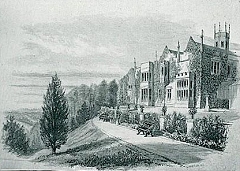
In 1868, Ephraim purchased Oakwood Hall, Romiley, a gothic-styled mansion which had been designed by Edward Walters for Ormerod Heyworth and built in 1844-5. It became the home of Ephraim, and his new wife Hannah, for the rest of their lives. A document of 1873 records his ownership of 163 acres of land.
For more about Oakwood Hall see Allan Russell's 'History of Stockport in 100 Halls' blog.
In 1871 they had living with them Margaret Andrew, Hannah's sister, and her son Percy Neville Andrew, whom Ephraim appears to adopted as his own son, and renamed him Percy Neville Andrew Hallam.
An accident occurred at Heaviley Mill in 1871; an iron beam gave way during some building alterations - possibly adding an extra storey - leading to collapse of part of the building. A worker, John McDermott, was killed.
In later years Ephraim was troubled by industial action, with two strikes in the 1890s.
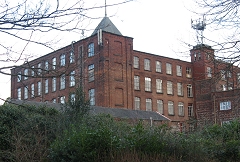
Ephraim died on Christmas Day 1897, and the following year the building offered for auction, along with all its equipment. A ready buyer from the building was Faulders, a firm which also occupied two factories in the town centre manufacturing jam, confectionery, cocoa and chocolate goods. They stripped out the interior, and transfered their sweet-making operation from from their original works on the banks of the Mersey.
Their products were branded 'Squirrel' which became the company name in 1930. Some may remember their 'cherry lips' which are still manufactured by others today.
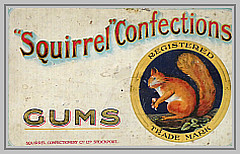
Squirrel Horn left the mill in 1968, after suffering a series of arson attacks. Production continued for a while at the nearby premises of John Horn. The two companies merged in 1980 and in 1990 production was later moved away from Stockport to Glenrothes in Scotland. The mill complex - including a building which now rejoices in the name of the 'Alcatraz Building' - became the home for a number of businesses of various kinds, a situation which continues today under the name of Hallam Mill.
To the east of the mill was a reservoir - later filled in to create a car park - to ensure a supply of water for the mill engines. Older residents recall feeding the swans there,
Legacy
Ephraim Hallam had intended to donate to the town, in celebration of Queen Victoria's Jubilee, in 1897. A piece of spare land adjacent to the mill as a recreation ground, but died before he could sign the deed. However, after some discussion his executors handed over the land and in 1902 the Hallam Recreation Ground was opened.
Ephraim Hallam's will made provision for his wife, and left the residue to any child of his adopted son Percy, who was educated at Clare College Cambridge, and later lived in London where he married, although he had returned to Stockport by the time of his death (leaving no children) in 1899.
Should there be no heir, Ephraim specified that the estate was to be formed into a foundation to be called the 'Ephraim Hallam Charity'. After some years the Charity was established with the money from the estate totalling £120,000, and 'in addition a sum of £18,500 from ' accrued income' was used to fund two-thirds of the cost of new building for Stockport Grammar School in open land on the edge of Davenport to replace the school's cramped quarters in the town centre. Opened in 1916, the school still flourishes as an independent school. The main hall is named 'Hallam Hall.'
The Charity has carried out many good works over the years, and still operates despite the unfortunate events in the 1990s and 2000s involving an accountant who appropriated some of the Charity's funds.
After its sale following Mrs Hallam's death, Oakwood Hall had a series of occupiers including a Jesuit seminary and an Approved School for Girls. It was the Kingsmoor School from 1956 to 1963, after which it became derelict and was partly demolished, but was saved and rebuilt in 2007-10 as apartments by a modern-day businessman, Mike Clark. Additional houses under construction in the grounds were destroyed in 2016 by a fire which was said to be 'suspicious', but the original house was not damaged. By 2021 the project been completed. For more about the Hall, visit 100 Halls website.
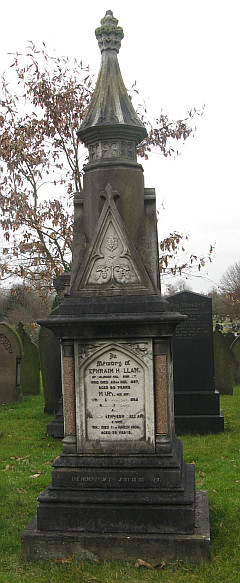
Stockport Cemetery
Contributions are very welcome at
charlie@
davenportstation.org.uk
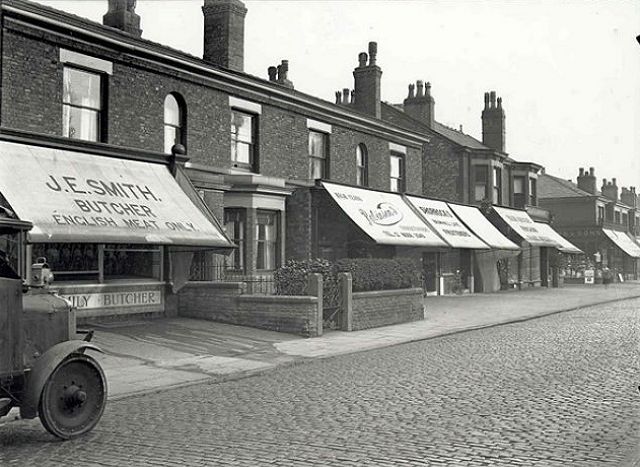
The picture above, from the 1920s, shows John Edward Smith's butcher's shop which had been created from half of the double-fronted house No. 201 Bramhall Lane; presumably the family continued to live in the other part, retaining the front garden. Its conjoined neighbour beyond, no.203, had already been transformed from a house into two shops, plus the single-storey extension beyond which can still be seen today. Each house would originally have had bay windows either side of the front door.
The other houses further along had also mostly been converted; all would have had front gardens when built, like the one in the picture. The developers who built these houses in the 1880s perhaps saw little need for a range of shops: middle-class families had their provisions delivered to their homes.
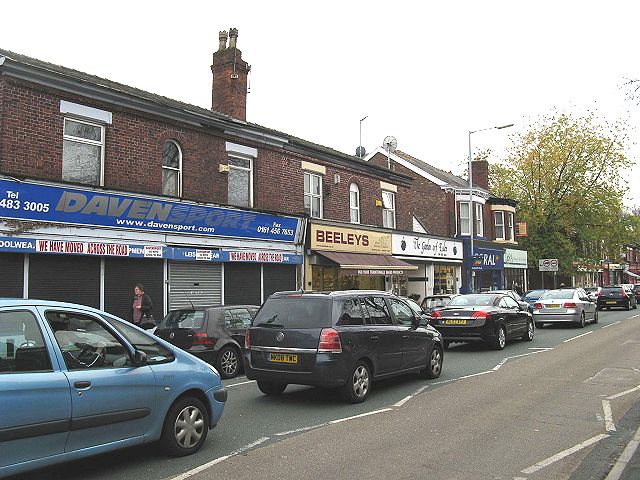
This picture, already historic although taken in 2009, shows the same view in more modern times.
The buildings beyond No.203, in a different architectural style originally with full-height bay windows, are on land formerly owned by the Dundonald family, and were built some years later: their story will eventually feature in another article.
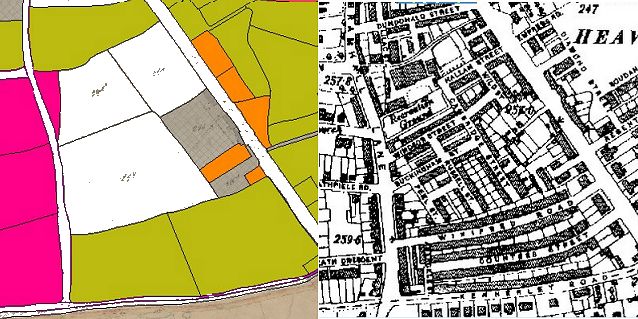
The layout of the buildings and roads along this part of Bramhall Lane is somewhat disjointed. To see how this came about we need to go back the Tithe Maps compiled around 1850, which detail the owners and occupiers of each 'parcel' of land. An extract is shown, colour-coded by land-owner, on the left of the image above, with a 1910 map of the same area alongside. The three fields coloured in white - subject of this article - were owned at that time by Mary Alcock, the wife of John Alcock, a Cotton-mill owner who lived in Bredbury. (For we know about Mary Alcock, see our Cabinets to Coffee feature.) They were rented to various farmers.
The green areas were owned by Lloyd Bamford Hesketh, and were later developed with the streets given names relating to his wife's family, Winifred, Countess of Dundonald. The pink area, including the odd triangle on the east side of Bramhall Lane, was part of Cale Green Farm, at that time owned by the 'Trustees of Dr. Thompson'. As the 1910 map shows, the odd triangle is preserved in the shape of the backyards of the terraced houses later built there and the mill buildings.
Not long after the date of the Tithe Maps, Mary Alcock's land was bought by Ephraim Hallam. On the northern part he built a cotton-spinning mill, Hallam Mill, which opened around 1859 (although some sources say earlier), and the row of houses in Hallam Street. The southern field he sold for building development, except for the area which was retained as a recreation ground and bequeathed to Stockport Corporation on his death in 1897.
Most of the remaining area became filled streets of terraced houses for workers, except for the frontage along Bramhall Lane which he reserved for larger houses. The land was sold in 1875 to Robert Johnson and David Fogg. Census records show that Johnson was a Book-keeper and Fogg a Mill Manager; they managed Hallam Mill on behalf of Mr Hallam. On the prime locations on Bramhall Lane and built houses for themselves and their families; by 1881 Johnson lived at no.189 (in 2014 the 'One Stop' Convenience store') and Fogg at no. 203. See '203 Bramhall Lane' below.
201 Bramhall Lane
No. 201 was unoccupied in 1881, perhaps awaiting a tenant. By 1891 one had been found, in the shape of Stockport-born James Bourne (aged 30) a metal agent (buyer and seller of metals).With him were his wife Annie Bourne, and daughters Edith Bourne and Annie Bourne. They had a live-in servant, Margaret Jackson.
James had inherted the business, trading in John Dalton Street, Manchester, as William Bourne, from his father William, but declared himself himself bankrupt in 1889 and working for another company. His life was marred by tragedy; he lost his wife Annie, and was married again in 1893 to Clara Geldard of Leeds in the Brunswick Wesleyan chapel there.
They left the Davenport area to live at at Turf Lea, Ridge End, Marple, but by 1911 they were back, with a son, William Herbert Bourne, and a daughter, Marian Bourne, at 'Brentwood', 83 Beech Road, Cale Green.
The next resident of No. 201 we have been able to trace - he is recorded as such (with mis-transcribed name) in the 1901 census - was George Edward Bouskill, a cotton waste dealer, who with his partner Samuel Rigby of Bramall Mount (on Bramhall Lane, a short walk away) carried on their business under the name of Samuel Rigby & Co. in a warehouse converted from the former weaving shed of Spring Bank Mill, Wellington Road South, Stockport, adjacent to the station. The firm was still at Spring Bank Mill in 1924, but by the 1930s had been sold to Cookson Brothers, and was later demolished. A street-name 'Spring Bank Place' survives in 2021 to mark the location.William Herbert Bourne was, like other young men of Beech Road, a member of the nearby Cricket and Lacrosse Clubs. With a group of his sporting friends he was keen to enlist in the 6th regiment, Manchester Regiment, only to join the ranks of the fallen during the Dardanelles conflict. He died on board H.M. hospital ship Gascon on 29 September 1915 and was buried at sea.
We know more than the average amount about Stockport-born Mr Bouskill, for the unhappy reason that both his sons were of the age to fight in The Great War, and only one returned. Born in Stockport in 1866, he married Sarah Emily Miller in 1890. They lived at 41 Beech Road, and 'The Hollies', 128 Buxton Road before moving in to No.201, where they stayed until around 1914, before moving into 'Bramhall Grange', a large house (demolished c.1930) on Bramhall Lane South opposite present-day Grange Road, across the border in Bramhall.
The 1911 census, whose transcribers also had trouble with his name, shows the occupants of No.201 as George Edward Bouskill (age 44), Cotton Waste Merchant, his wife Sarah Emily and their two children Clifford Bouskill (17) and Edward Bouskill (14) with a general servant Nellie Smith (aged 19, born in Rugeley, Staffordshire.) Clifford was working in his father's firm until he answered Lord Kitchener's call, and found himself involved in the tragic events at Gallipoli. He survived the war, and in 1922 married Doris, daughter of James Pailin, who lived at 'Romanhurst', 229 Bramhall Lane South, a large secluded house set back from the road on the edge of Bramhall Park.
Edward Bouskill was a student at Manchester College of Technology at the outbreak of the war, and after twelve weeks' training in the Manchester University Officer Training Corps. became a Second Lieutenant in the 22nd Battalion of the Manchester Regiment. He died in 1917 at the Third Battle of Ypres, and is commemorated on the St George's Church war memorial, as well as the Bramhall and Stockport Memorials; today his story can be found on the marvellous Stockport 1914-18 website. (this is longer live: this link goes to a copy on the Internet Archive.)
Converted to a shop
After the Bouskills left, No. 201 became J.E. Smith's butchers' shop, as described above, and remained so for many years, as John Edward Smith is mentioned in a Land Registry record for No.201 in 1956, and the business appears in telephone directories for the last time in 1958.
John Edward Smith was born around 1880 in Leek, Staffordshire. the 1911 census lists him as butcher working from home a few doors along at 213 Bramhall Lane, a smaller shop which later became part of the grocery shop we know as 'Spar.' His household included his wife Isabelle Smith and his three sons, John Edward Smith (junior), Arthur Smith and Eric Smith, as well as his brother, Sydney Smith.
From 1959 to 1965, Telephone Directories record 201 Bramhall Lane as the premises of E.B. Marshall, furnishers, who had previously operated from two 'China and Glass' shops at 20 Bramhall Lane and 341 Buxton Road. Mr Marshall did not live on the premises, but at 57 Bridge Lane, Bramhall. Probably this time the shop front had probably been extended to the full width of the original house.
The occupiers of No.201 from 1965 until 1981 have eluded me as there are no simple ways to locate the information - can anyone help?
We do know that 'Davensport, Sportswear and equipment' at no. 201 appears in the Telephone Directory for the first time in 1982. In 2008 the business re-located to a former ladies' outfitters across the road at 98 Bramhall Lane (see our feature Walton's Terrace), perhaps because there is parking space at the front of the shop. The present company dates from 2002. No. 201 became an abandoned, and shuttered, eyesore, the premises re-opened in late 2014 as a discount homewares store, 'The Pound Stop', which still thrives in 2001, despite some letters falling off its facia.
203 Bramhall Lane
The story of no.203 is complicated by the fact that in the house was divided to become two shops, as well as a flat above, and at some time a 'lean-to' extension was added to house another shop.
When first built as a single house, no.203 was the home of David Fogg, Ephraim Hallam's mill manager and the owner of the house, as noted above. His wife Elizabeth was Ephraim Hallam's sister, which perhaps aided his rise to be the works manager.
The 1881 census lists David, aged 51, with his wife Elizabeth Fogg (50), daughter Mary Hannah Fogg (25) and son Ephraim Ernest Fogg (12, scholar) plus a domestic servant, Sarah Ann Epsom(?) aged 21. 1891 saw David and Mary only, with a servant, Laura Price (18). At this time there were no further buildings along this side of Bramhall Lane as far as the junction with Kennerley Road.
By 1901 David Fogg had retired, and moved to 195 Bramhall Lane. The 1911 census found him aged 81, having moved in with his son Ephraim Ernest Fogg and family at 18 Beech Road. He died in September of that year, leaving assets of over £25,000. The family remained at 18 Beech Road. Ephraim Ernest Fogg, who worked in the hatting industry and later as an outfitter's agent, died there in 1927. The Beech Road house was finally sold by surviving daughter Emily Fogg in 1940.
The Greens
By 1901 the house had become a doctor's surgery, presided over by Joseph Green, aged 33, physician and surgeon, with his wife Helena Green (30, née Banks), the children Lois Green (6) and Joseph junior (2). The Greens had previously lived at 59 Buxton Road. There were two live-in servants: cook Mary Bibby, born in Liverpool and a Nurse, Lizzie Morris, born in Carnarvon, Wales.
Another daughter, Frances Green, was born in 1902, but soon afterwards things began to go wrong. Joseph took a fancy to a former domestic servant, Mary Ellen Parry, who had left in 1900 to marry a local joiner, John Lewis Jones. Inevitably the liaison was discovered. Soon afterwards Mary said she was 'going to Alderley Edge for a few hours', and did not return. Eventually news arrived that she had travelled to New Zealand 'under the protection of Dr Green'. Helena and the children moved to Macclesfield.
The Bentleys
By 1911 the householder was 37-year-old Henry Bentley, who described himself as a surgeon. With him was his wife Lily Beatrice Bentley (35) and one-year-old son Geoffrey Bentley. Two servants lived with them: Annie Eliza Percy (42, born in Northumberland) and Rosa Jepson (16, born in Stockport). The census informs us that the house had 9 rooms, not counting any scullery, landing, lobby, closet, bathroom, warehouse or shop.
Henry (also known as Harry), born in Manchester, did not come from a line of medical practitioners: his father Richard Bentley, born in Chorley, Lancashire was a baker and confectioner, and the family home in 1901 was 31 Beech Road, a short walk from Bramhall Lane. (Beech Road crops up very often in our researches: one could write a book about all the interesting people who have lived there at some time. Our Beech Road feature chronicles a few of them,) Harry was listed as a Medical Student, aged 24, probably attending the Manchester Medical School. He qualified in 1905, and in the same year married Lily Beatrice Rae; no.203 was possibly his first married home and practice.
In January 1912, Henry Bentley became local and national news when he was charged with the manslaughter of Joseph Oldham, a resident of Great Moor who, helped by a friend, 0n the evening of 9 January was pushing a hand cart along the main Buxton Road (with front and back lights). He died from his injuries and loss of blood after being struck by a car, allegedly driven by Bentley, which did not stop. Witnesses at the inquest and his subsequent appearance before the Magistrates (which was reported in detail in the local newspapers) named his Darracq two-seater car (registration DB 383 or 389?) as the the vehicle involved, and identified him as him as the driver; a policeman who later went to his garage, photographed damage to the car and found traces of hair on the headlamp.Bentley was still listed at 203 in a 1919 medical directory, but by 1923 the couple had moved to Bridgend, South Wales. Henry and Lily appear in the 1939 register, living at Branksome House, New Milton, Hampshire; Henry died in Lincolnshire in 1946; Lily died in Lincolnshire in 1967.
He told the police that he had hit a gatepost while putting the car in the garage, but a young boy, Ernest Arnold, who worked in the evenings for Mr Ringham, owner of a boot shop next door to the surgery, told the magistrates that he had seen the damage earlier when Dr Bentley had stopped to set down his passenger, hat manufacturer Joseph Harrison, who incidentally features in our Selwood article.
Bentley was freed on bail to appear at Chester Assizes in March 1912, where he was acquitted. This trial was not so well reported; his defence seems to have been that he didn't see the cart and didn't know he had hit anything.
Converted to Shops
Around 1920, the building was converted into two shops. It appears that the half on the right when viewed from Bramhall Lane retained the number 203, whilst that on the left became 203a.
No. 203a apparently started its retail life as a confectionery shop: 'Robinson's confectioners' can be made out on the sun blind in the original of our heading. More information about this business eludes us at present; neither the 1921 Census or a 1923 directory were able to assist. A later owner was Allen Kenneth Wright, listed at 203a as a confectioner in 1934.
By 1955, 203a had become a butcher's, run by James Edward Whalley. Born in 1915, he appears in the 1939 register as a butcher's shop assistant living at 26 Goyt Road, Stockport. (His wife Dilys had an interesting occupation - welfare worker at Marks and Spencer's store.) Having learned the trade, he set up his own shop. He was still there in 1965, when his final entry in the Telephone Directory appeared. He died in 1992 at 36 Adelaide Road, Edgeley.
We then 'lose sight' of the shop for a while, until the early 1980s when it was a branch of Beeley's Bakery, a small chain of shops which also had premises at 142b Shaw Heath, 321a and 437 Buxton Road Great Moor, and 37 High Street, Cheadle. (I recall a Beeley's bakery shop in my old home town of Whaley Bridge, maybe that was another branch of the family.) In the 2000s the bakery operation appears to have been given up, although the Beeley firm still exists as a property company based in Macclesfield. The original shop in Shaw Heath was abandoned, and was still empty in 2022 looking increasingly dilapidated.
The Davenport Beeley's shop was rescued by a company named 'Just Desserts' founded in 2013 which took over the business, and retained Beeley's shop frontage and colour with just a change of name. It remains busy in 2021.
As for no. 203, Thomas Shorrock (born in 1882), a fruiterer, is listed in the 1921 census. This records lists Thomas, his wife Emma Shorrock (age 42) with their sons Harry Shorrock, (20), and Thomas Shorrock (11) along with daughters Emma Sharrock (14) and Violet Sharrock (4) All were Stockport born except Emma (senior) who hailed from Birmingham.
Thomas had previously had live-in shop premises at 60 Buxton Road, Heaviley; he moved to Bramhall Lane when the shop became available, perhaps hoping for a more affluent clientele.
When the national register was taken in 1939, Thomas was still there. With him was his wife Emma Shorrock, his son, also Thomas Shorrock, both helping with the business, and a lodger, Arthur Holt, a hat dryer's assistant. Thomas (senior) died in 1945; perhaps the family carried on the business for a while, but the 1955 Telephone directory lists R. Staley, greengrocer and fruiterer, a business which survived until 1980.
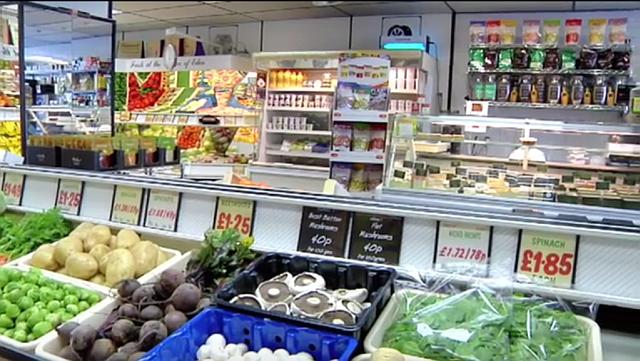
The next occupier we can trace was still a greengrocer, established in 1986 with the fanciful name 'The Garden of Eden'. It was run very efficiently by two brothers, one bringing the produce from the market and the other running the shop. The picture above is a still from a YouTube video made for the original management in the heyday of the business. They even had a branch in Bramhall precinct for a while.
Sadly, after changes of management in the 2000s, with periods of closure, it seemed to lose its way, and closed for good in 2016; by at the end of 2017 the premises remained shuttered. On a personal note, this was a serious blow to us, as we were able to walk there with our shopping basket, for the weekly shop; today we are obliged to get our greengrocery from supermarkets.
However, in 2018 the shop was taken on by a chef, Peter Sweeney, for conversion to a 'bistro'-style restaurant to be known as '203 the Lane' , despite protests by some locals who predicted car parking problems and noise. On opening it suffered some early setbacks and closed for a while, then re-opened again, but eventually closed permanently in 2021, replaced by a Chinese restaurant called 'Chinese 203'. They tell us online: "Eat as much as you can, £18 per person. We provide table service, so you can sit and relax with your food. Fully licenced bar on site."
The 'lean-to' (203b) by 1934 had become a butcher's run by Harry Robertson Siddons. Mr Siddons, who appears to have learned the trade in Blackpool, did not live at the shop: the 1939 census lists him at 64 Oakfield Road, Davenport. At some time, it ceased to be a separate shop, and became part of no.203.
Hallam's buildings
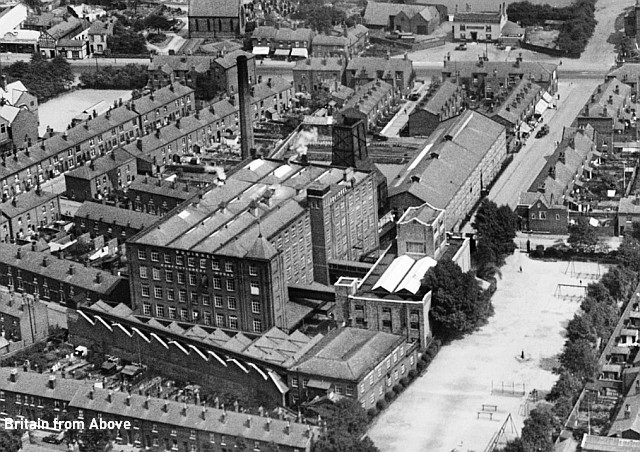
Hallam Mill, then the Squirrel Confectionery Works, from the air, 1927. Notice the Bamford Arms inn before it was enlarged (top right), the Hallam Recreation Ground, then with a hard surface, and the triangular row of gardens bottom left, once a detched part of Cale Green Farm.
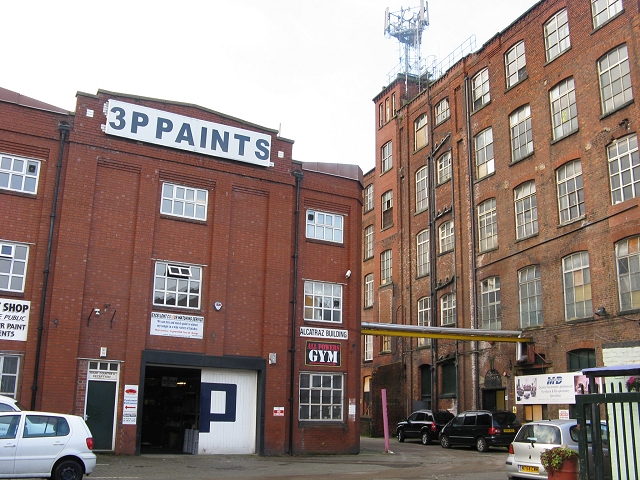
Hallam Mill from Hallam Street, 2015. The '3P Paints' sign almost covers the name 'SQUIRREL'.
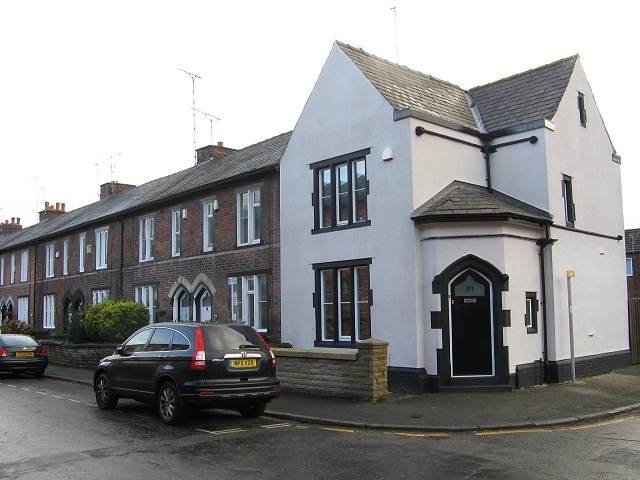
Opposite Heaviley Mill, Ephraim Hallam provided this row of houses, Hallam Terrace, on what became Hallam Street. They have the look of a row of almshouses, but were actually homes for the senior staff of the mill and others. The nearest house to the camera was home to Heaviley Mill manager David Fogg for a while.
For the other houses on Hallam land, see our features Cabinets to Coffee for nos 175 - 179 and Walton's Terrace for 181 - 199.
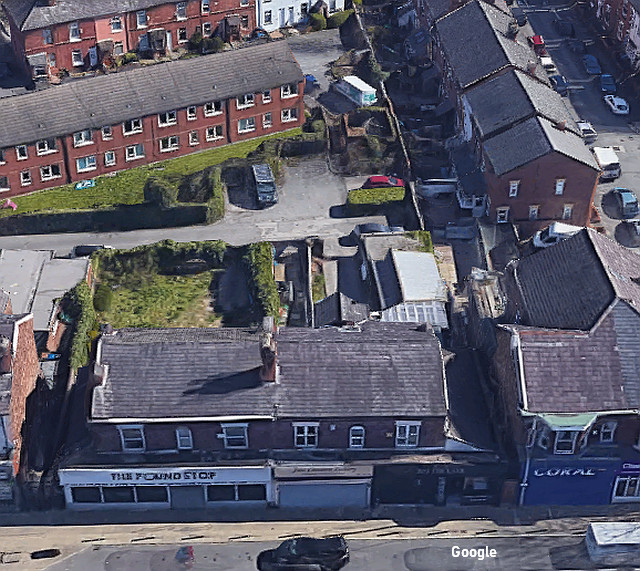
Aerial view of 201 and 203, circa 2019. The boundary between Hallam land and Bamford Hesketh land is clearly seen, and the single storey extensions at each end.
Sources
We have used the Ancestry and Findmypast websites, the online Land Registry and the Stockport Image Archive in compiling this piece, as well as street directories and postcards in our own collection, the 'Britain from Above' website, the British Newspaper Archive, Google Maps, and many other sources.
The accident report is from The Alderley and Wilmslow Advertiser, January 28 1912. This newspaper was published in Stockport alongside the Stockport Advertiser, which like its rival the Stockport Express has yet to be digitised by the British Newspaper Archive, and is only available on microfilm.
Written by Charlie Hulme. Revised January 2022